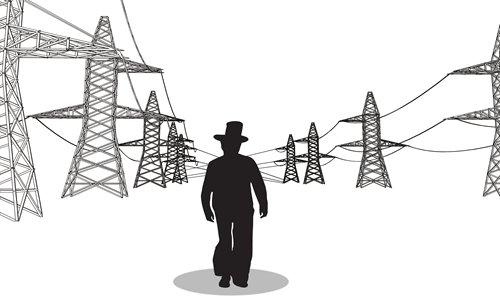HOME >> BUSINESS
China’s UHV development offers lessons for US
By Li Qiaoyi Source:Global Times Published: 2019/5/30 18:23:42

Illustration: Luo Xuan/GT
China's push for power transmission efficiency and smart energy use ought to provoke questions about what other global energy consumers, including the US, are supposed to do to improve energy sufficiency and efficiency.
Chinese solutions to smart energy centered around ultra high voltage (UHV) development could be another claim to fame abroad, much like the country's high-speed rail. The nation's UHV strength could possibly be leveraged to foster cooperation between China and the US, which are still locked in trade tensions.
China has made no secret of its approach of enabling efficient, cost effective and environmentally friendly power transmission - creating a national network of UHV transmission lines that transmit energy over a long distance, linking far-off interior regions abundant in solar, wind and hydro resources to energy-thirsty coastal regions. Apart from the UHV push led by state-owned State Grid Corp of China (SGCC), the world's largest utility company, wide-ranging efforts are under way to facilitate the use of energy in a smart, integrated manner.
Earlier this month, I attended a media tour around Suzhou, East China's Jiangsu Province, a model city of the technology-driven energy revolution. The three-day tour offered detailed insights into the well-functioning ecosystem that underpins the country's energy prowess.
To start with, I was impressed by the Dongwu substation in Suzhou, the world's largest UHV alternating current transmission substation, which occupies an area of 142,000 square meters, or the size of 20 regular soccer fields. The substation, which involved an investment of 2.29 billion yuan ($330.76 million), is designed to provide guaranteed power supply to both Shanghai and Jiangsu Province. It is significant for improving the receptive capacity of clean energy in East China, as well as enhancing the capability of the grid in the Yangtze River Delta to withstand major power system faults.
The gigantic substation is equipped with roaming robots that facilitate its smart monitoring and operation. As a consequence, only four staffers are required for daily maintenance of the substation.
The 5.4-kilometer-long Sutong gas-insulated line (GIL) tunnel, the world's first tunnel enabling underground UHV distribution, is also an impressive sight to behold. Running 74.83 meters at its deepest point below the Yangtze in Jiangsu, the GIL tunnel is expected to be put into use at the end of September.
Additionally, the 500 kV unified power flow controller (UPFC) project in Suzhou's southern power grid, put into operation in 2017, has become the world's largest-capacity and highest-voltage grade UPFC project. UPFC, an advanced and flexible transmission technology, enables navigation to other routes in case of traffic jams on electricity transmission pathways. It is worth pointing out that China is home to three of the world's six UPFC projects.
These are strong proof that China is out in front in the development of UHV lines and supporting facilities. The country has already exported its UHV strength to other countries. For example, SGCC is now building a second 800 kV UHV line in Brazil after having built the first, which is now operational and transmits energy to Brazil's southeastern states.
India, projected to soon become the world's third-largest energy consumer following the US and China, has also been moving toward a UHV-focused transmission system.
The US, a major global energy producer and consumer, has nevertheless made slow progress in building a powerful national electricity grid, mostly strangled by the nation's energy policy.
That said, the US should think about what it can learn from China's UHV push, especially taking into account the similarity between the two countries in energy transmission. UHV transmission lines that have been or are being built across China are supposed to boost renewable energy adoption, effectively sending power to densely populated areas with low renewable potential from areas with lower population density but high renewable potential. The US is facing a similar issue with renewable energy adoption, but it has lagged far behind in UHV development.
This is not a new concern for industry insiders in the US. An article posted back in 2011 on greeneconomypost.com argued that "the US continues to do nothing more substantial than litigate," while other parts of the world are busy actually building national UHV transmission infrastructure.
Saying that a UHV transmission superstructure is a solution to the aging transmission infrastructure that cripples the US, the article enumerated a number of UHV projects planned by SGCC.
Eight years on, the situation seems not to have changed much. An open letter to US Congresswoman Alexandria Ocasio-Cortez published by local US newspaper Calaveras Enterprise in April proposed redesigning and rebuilding the US power grid by building a UHV electricity transmission power grid. Citing UHV development in China since 2009, the open letter argues that the UHV power grid "will require large upfront capital investments from government and private investors, but it will be contributing to the general welfare of We the People for generations to come."
The call made by the US people for a more effective UHV push apparently points to an area of cooperation that is supposedly to be taken seriously by the US government, which has become somewhat addicted to a protectionist mindset.
China's adeptness in integrating emerging technologies into its powerful energy infrastructure could help motivate minds to change.
A road 500 meters long and 3.5 meters wide in Tongli Comprehensive Energy Service Center in Suzhou, the world's longest road providing dynamic wireless charging, might serve as a catalyst for a change of heart. The three-in-one highway simultaneously features self driving, solar power charging and wireless charging, arguably a mind-blowing slice of innovation.
The author is a reporter with the Global Times. bizopinion@globaltimes.com.cn
Posted in: INSIDER'S EYE